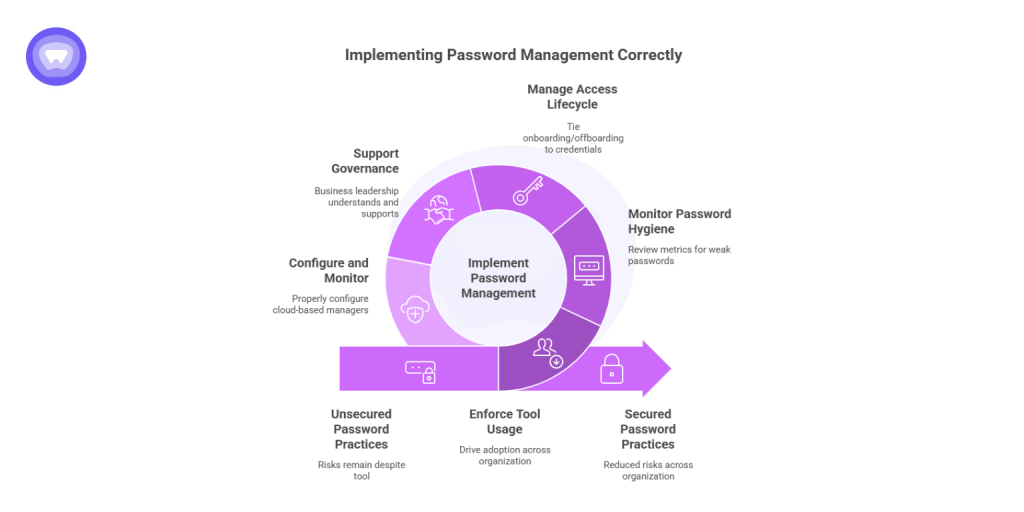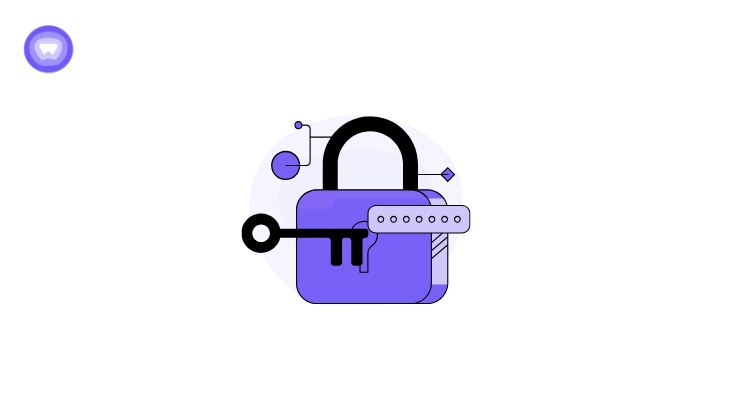- Most SMB breaches stem from weak or shared passwords, not advanced hacks.
- A password manager centralizes control, enforces strong credentials, and simplifies secure access.
- On-premise and white-label options let SMBs own their data, deployment, and branding.
- Tracking KPIs like vault adoption and weak password reduction proves ongoing value.
- PureWL’s Password Manager combines security, scalability, and brand flexibility for growing businesses.
Small businesses rarely fall to million-dollar hacks, they fall to one forgotten password. A shared login left unchanged, a spreadsheet emailed “just once,” a contractor who still has access months later. These quiet cracks cost SMBs more than ransomware ever could.
Credential leaks and unmanaged access now drive most small business breaches, yet many teams still treat passwords as an afterthought. The truth is, poor password management doesn’t just expose data, it erodes trust and slows growth.
A password manager for SMBs solves this at the source. It centralizes control, enforces good security habits, and protects every account your business relies on, a simple, scalable way to secure growth without adding complexity.
What Is a Password Manager for SMBs?
A password manager for SMBs is a secure platform that stores, manages, and shares business credentials across teams in an encrypted vault. It eliminates the need for spreadsheets or browser-stored passwords by generating strong, unique credentials and autofilling them only when authorized.
For small and medium-sized businesses, it provides centralized control, letting administrators assign permissions, monitor access, and revoke credentials instantly when employees change roles or leave. The result is tighter security, simpler access management, and fewer risks from human error or credential leaks.
Why SMBs Are Attractive Targets and How Credentials Play a Big Role?

SMBs are no longer fringe targets, they are prime targets. According to a recent industry snapshot, identity-based attacks are on the rise and credentials are the entry point. The Cybersecurity and Infrastructure Security Agency (CISA) explicitly warns that “weak or stolen passwords are one of the easiest ways [cybercriminals] get into businesses”, especially SMBs.
The Hidden Cost of Unmanaged Passwords
For SMBs, the cost of a credential-based breach can be disproportionately high. Employee offboarding, credential reuse across services, insecure sharing (via spreadsheets or email) all magnify risk. Statistics show:
- Users without a password manager were nearly twice as likely to suffer identity or credential theft in the past year (32%) compared to users with one (17%).
- According to SMBGuide’s 2025 report, the number of people using password managers increased by 60% between 2022 and 2023, yet a significant portion of SMBs remain unprotected.
- A 2024 survey reported 37% of respondents considered their workplace security habits “risky,” with insecure password storage and weak credentials among the main culprits.
These data points underline that implementing a password manager for SMBs is not optional, it is a foundational step in risk mitigation.
What SMBs Should Expect From a Good Password Manager?
When evaluating solutions for SMBs, especially those that may want control over deployment (on-premise) or a white-label/private-label option, look for the following features:
Core Security and Governance capabilities

- Unique, strong password generation and storage: The system should enforce unique credentials (no reuse) and strong complexity.
- Admin and audit controls: Ability to monitor access, enforce roles, and control sharing.
- Multi-factor authentication (MFA) support: Because a strong password is only one layer; MFA adds critical protection.
- Secure sharing and password vaults for teams: Rather than emailing credentials, teams should share within the encrypted environment.
- Policy enforcement and visibility: For example, detecting weak or reused passwords, tracking compliance.
- Deployment flexibility: On-premise or private-label options let businesses retain control and branding (if desired).
- Scalability and usability: The tool must be easy to adopt by employees, minimizing friction so that security is not bypassed.
Five Practical Steps for SMBs to Improve Security via a Password Manager
Here’s a practical rollout path for SMBs to improve security through a password manager:
| Step | Action | Benefit |
| 1. Inventory & policy audit | Identify all services, shared accounts, users, and password-sharing practices. | Understand the starting point and risk exposure. |
| 2. Select & deploy the tool | Choose a solution that meets the criteria above (governance, MFA, sharing, deployment flexibility). | Builds the technical foundation for improved credential security. |
| 3. Migrate existing credentials | Move existing credentials into the vault, enforce unique password creation, retire legacy spreadsheets/emails. | Eliminates scattered credential silos and reuse. |
| 4. Train employees & enforce use | Educate staff about password hygiene, require use of the vault, enforce MFA and policy rules. | Ensures adoption and consistent secure behavior. |
| 5. Ongoing monitoring & review | Use the tool to audit weak/reused passwords, review access logs, rotate credentials as needed. | Maintains the security posture over time and shows ROI. |
By following this path, even a small in-house IT team can significantly raise the security bar without needing large specialist cybersecurity resources.
Why an On-Premise/White-Label Password Manager Is Especially Valuable for SMBs?

Choosing a “generic cloud” password manager may work, but there are compelling reasons for SMBs to choose an on-premise password manager or white-label solution:
- Control over infrastructure: Hosting on-premise means you retain control over where the data resides, how backups are managed, and compliance requirements.
- Customization and branding: A white-label version gives you control over the branding and user interface, which can help with internal adoption and branding consistency.
- Alignment with governance: Some SMBs, especially those serving regulated sectors, need stronger governance and audit trails. On-premise gives you more visibility.
- Scalable with your growth: As your team grows, you may want to integrate with single sign-on (SSO) or other identity systems. A more flexible deployment supports that growth.
- Cost predictability: On-premise or private-label deployments can offer predictable licensing models rather than variable cloud usage fees.
Because SMBs often have resource constraints, choosing a password manager for SMBs that offers these deployment options ensures that the tool remains relevant as the business scales or is acquired, or enters more regulated verticals.
Common Pitfalls SMBs Must Avoid

Putting in a best password manager is a big win, but only if done correctly. Common pitfalls include:
- Choosing the tool, but not enforcing usage: Adoption is key. If employees continue to use spreadsheets or reuse passwords, risk remains.
- Ignoring password hygiene metrics: Without ongoing review (weak passwords, reused ones, dormant accounts) the risk returns.
- Focusing only on passwords, not access lifecycle: Employee onboarding and offboarding must tie into credential management, without that, former employees may retain access.
- Treating password management as IT only: The business leadership needs to understand and support the governance, since credentials touch every department.
- Assuming cloud means “set-and-forget”: Even cloud-based password managers can become attack vectors if not properly configured and monitored. For instance, research shows password managers themselves are subject to threats.
Avoiding these pitfalls helps ensure the best password manager for small businesses actually delivers the intended security uplift.
KPIs to Track with Your Password Manager for SMBs
Measuring the success of your password manager helps demonstrate value and sustain long-term security momentum. Key KPIs include the percentage of accounts migrated into the secure vault, the number of shared credentials eliminated, and the count of weak or reused passwords replaced.
Tracking credential revocation time after offboarding, incidents of misuse or unauthorized access, and employee adoption rates also reveal how effectively the solution fits into daily workflows. Regularly reviewing these metrics supports smarter decisions and justifies continued investment in stronger security initiatives.
What SMBs Should Know?
Here are a few key considerations for SMBs regarding free business password managers:
- Credential-based attacks are expected to continue growing, with attackers increasingly focusing on stolen or reused credentials.
- Password managers themselves have come under attack. Research highlights vulnerabilities in autofill frameworks, click-jacking risks and mobile autofill, meaning SMBs must ensure the tool they choose is up to date and well maintained.
- Usability remains a key adoption hurdle; solutions with intuitive interfaces and strong admin support are more likely to succeed in SMB environments.
- Integration with broader identity and access management (IAM) practices is becoming essential even for small businesses, not just large enterprises.
PureWL – A Practical Solution for Businesses

When your business needs a password management solution with full control, brand flexibility, and enterprise-grade protection, the PureWL Password Manager delivers. Built for MSPs, SaaS providers, and SMB platforms, it lets you host, brand, and manage your own secure system, ensuring total data ownership and governance through on-premise or private cloud deployment.
PureWL goes beyond security by strengthening trust and enhancing your brand experience. Its customizable Security Dashboard, encrypted vaults, and shared access features simplify password management for teams while maintaining strict access control. With audit logging, built-in password generation, and easy user management, PureWL offers a seamless, branded security experience, combining protection, performance, and personalization in one platform.
Final Thoughts
For small and medium-sized businesses, the decision to adopt a password manager for SMBs is decisive: it moves credential hygiene from informal to governed, from scattered to centralized, and from risky to resilient.
When implemented thoughtfully, with policy, training, monitoring and the right deployment model, it becomes a foundational element of your security strategy. As you grow, your credential infrastructure will scale securely, adoption will deepen, and you’ll reduce the surface area for one of the most common cyberattacks: stolen or misused passwords. With a strategy in place and a solution tailored to your needs, you won’t just check a security box, you’ll build a stronger, more confident business.


